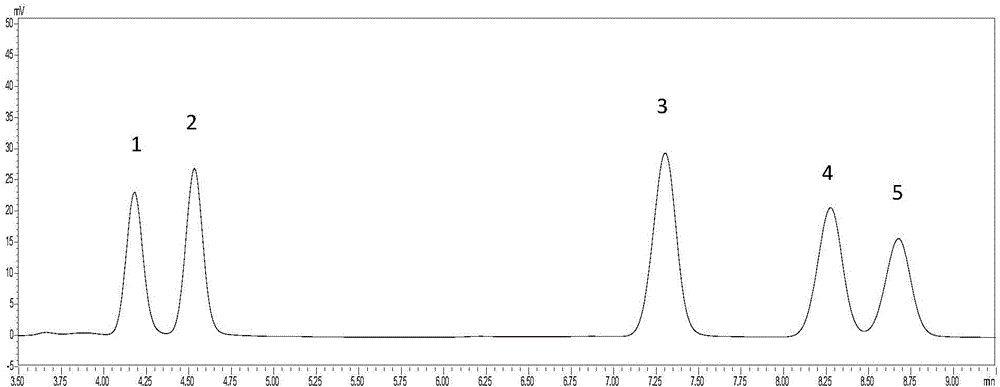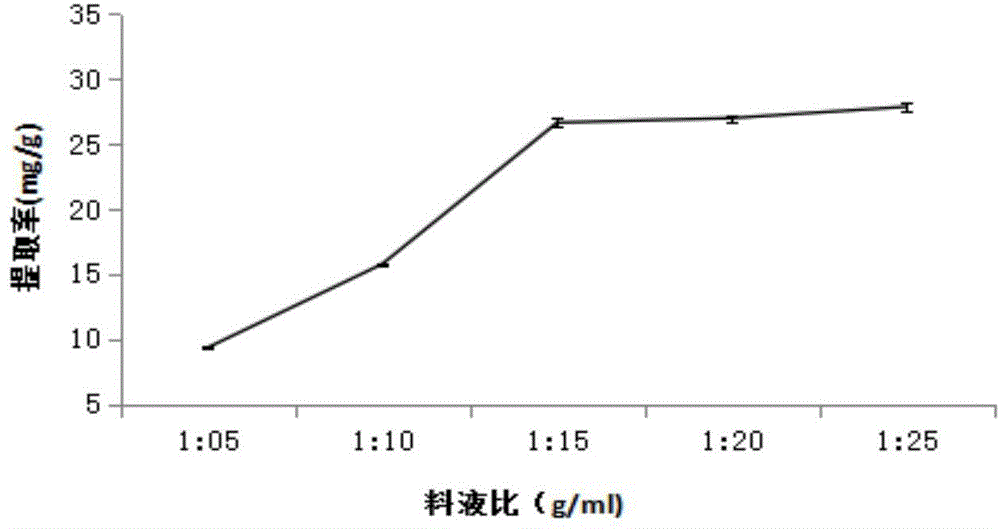Method for simultaneously detecting five triterpene acid components in Cornus officinalis by utilizing UFLC method
A technology of cornus officinalis and triterpenoid acids, which is applied in the field of simultaneous detection of five triterpenoid acids in Cornus officinalis, can solve the problems of long analysis time, difficult separation and the like, and achieves the effects of good separation effect, easy operation, and accurate and reliable measurement results.
- Summary
- Abstract
- Description
- Claims
- Application Information
AI Technical Summary
Problems solved by technology
Method used
Image
Examples
preparation example Construction
[0041] 2.1 Preparation of mixed reference solution
[0042] Precisely weigh 0.7 mg of ursolic acid, oleanolic acid, maslinic acid, and corosolic acid reference substance, and 1.4 mg of betulinic acid reference substance, dissolve in methanol, and dilute to a 1 mL volumetric flask. Precisely measure 200 μL of each of the above 5 reference solutions and place them in a 1 mL volumetric flask, filter through a 0.22 μm microporous membrane, take the subsequent filtrate, and mix the continuous filtrate to obtain a mixed reference solution.
[0043] 2.2 Preparation of the test solution
[0044] Precisely weigh 1.00g of Cornus officinalis powder, put it in a XO-200 type special glass reaction flask, add 5-25mL of ethanol solution with a volume fraction of 60-90% and seal it, weigh the mass as A, connect the reflux device, and place it in the XO- 200 ultrasonic-microwave combined reaction system for extraction for 6-15min, wherein, microwave power is 100-500W, ultrasonic power is 120-...
Embodiment 1
[0072] Example 1 Selection of solid-liquid ratio
[0073] In this example, five solid-liquid ratios of 1:5, 1:10, 1:15, 1:20, and 1:25 were selected to extract the Cornus officinalis powder respectively, and 1 g of Cornus officinalis powder was taken and placed in an XO-200 type special glass. In the reaction flask, different volumes of 60% ethanol were respectively added, the ultrasonic power was 300w, the temperature was 50°C, the microwave power was 400w, and the extraction time was 5min. Take the supernatant respectively, and use the vanillin-perchloric acid chromogenic method to measure the total triterpene acid content; such as image 3 The results show that the extraction rate increases with the increase of the ratio of solid to liquid at 1:5 to 1:15, and the change of extraction rate decreases when the ratio of solid to liquid is 1:20 to 1:25. In the invention, the ratio of solid to liquid is determined to be 1:15~1:25. Considering the purpose of saving solvent, 1:20 ...
Embodiment 2
[0074] Example 2 Selection of Extraction Time
[0075] In this example, the effect of different extraction times on the extraction rate of total triterpene acids was investigated. 1 g of Cornus officinalis powder was placed in an XO-200 special glass reaction flask, 20 mL of 60% ethanol by volume was added, the ultrasonic power was 300w, the microwave power was 400w, and the temperature 50°C, the extraction time was 3, 6, 9, 12, and 15 min, respectively, and the extraction was performed in sequence according to different extraction times. Take the supernatant respectively, and use the vanillin-perchloric acid chromogenic method to measure the total triterpene acid content; such as Figure 4 As shown, the results show that when the extraction time is 3-9 min, the extraction rate increases sequentially, and when the extraction time is 9-15 min, the extraction rate decreases sequentially. Therefore, in the present invention, the extraction time is determined to be 6 to 15 minute...
PUM
 Login to View More
Login to View More Abstract
Description
Claims
Application Information
 Login to View More
Login to View More - R&D
- Intellectual Property
- Life Sciences
- Materials
- Tech Scout
- Unparalleled Data Quality
- Higher Quality Content
- 60% Fewer Hallucinations
Browse by: Latest US Patents, China's latest patents, Technical Efficacy Thesaurus, Application Domain, Technology Topic, Popular Technical Reports.
© 2025 PatSnap. All rights reserved.Legal|Privacy policy|Modern Slavery Act Transparency Statement|Sitemap|About US| Contact US: help@patsnap.com



